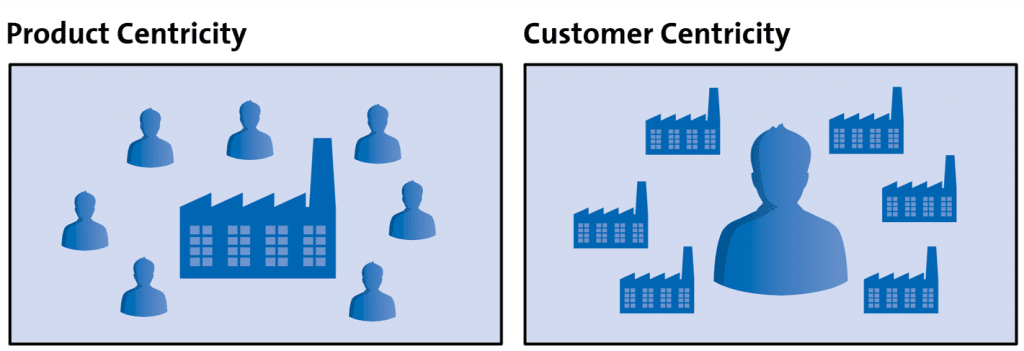Before getting into the detail of what customer centricity is, it makes sense to understand why the topic is growing in relevance, directly affecting the competitive advantage of enterprises. Customer centricity has always been significant, as the intent of most businesses is to deliver relevant offerings to their customers that lead to greater revenue and ultimately to profit.
Today, in order to maintain or grow market standing and retain competitiveness, it is even more essential to put the customer at the centre of the organisation’s business model.
The reason is partially related to the rapid changes and advances in technology and communication, combined with explosive growth in data and information, which have given rise to significant changes in customer behaviour. Digital-age customer behaviour is more dynamic; customers are global, more knowledgeable and empowered. The digital customer is more demanding, more geographically and vendor independent, more diverse, more challenging, more sophisticated and increasingly hedonistic.[1] A competitive advantage can only be achieved if these emerging characteristics of the ‘new’ customer are adequately and efficiently addressed.
Social media is an integral part of the digital age and allows unprecedented access to information, such as peer-to-peer product and service reviews, and the opinions of other customers around the world. As such, it gives greater power to consumers, making them better informed and more demanding. These experiences are shaping consumer expectations across all industry sectors.
A more demanding customer is only one side of the equation. On the other side, service providers today have the tools at hand to really understand their clients and deliver a customer-centric service. The challenge is to develop the capability to exploit this potential using the information and tools available.
Coming back to the initial question about the meaning of customer centricity, we suggest taking a common view of the client across the entire value chain. This view of the client usually includes a variety of profile attributes. In the context of this section, we are primarily talking about external customers who can be a single person, organisations, or the market itself. However, similar considerations are also valid for internal clients.
Here is a list of potential customer attributes to consider:
- Type of business, consumer demands and expectations
- Loyalty and retention
- Market and growth potential
- Degree of customer satisfaction with respect to products or services
- Indications of what excites the customer and potential to exceed their expectations
- End-to-end process from the customer viewpoint and how an offering fts into this process.
Two major paradigm changes result from customer centricity in the digital age: first, the focus of organisations will have to change from a product or production approach to a service delivery approach, where the product is strongly linked to the customer’s experience in its context; second, organisations need to focus on stakeholder value rather than on shareholder value – putting at the centre the value that can be delivered to the customer (which then delivers short- and long-term revenue).
The need to change paradigm results from the technical feasibility of orchestrating services in new ways, brought by digitalisation and the increased transparency of the market.
It is now the client who puts their own end-to-end needs into focus. The client assumes that they can combine different services to achieve their ultimate goal.
Vendors who are unable or unwilling to deliver according to new customer expectations will be wiped away in a globalised, competitive market.
If you adopt product centricity, focusing too much on the product instead of the customer, then you can expect to fail.
No-one buys a product that does not respond to needs. Furthermore, customer centricity does not end with the product purchase – it is part of a bigger picture. You want customers to buy again; you want to reduce churn. So, customer centricity looks at the total lifetime value of a customer.
The adoption of a customer-centric approach impacts on all aspects of the organisation, encompassing the business model (being agile in the face of the changing market and customer dynamics and enabling a customer-centric approach), people, processes, IT, brand and market positioning, customer segmentation, service distribution management, segment-based value propositions and service delivery, customer lifetime value management and culture, decision-making and operations.
Each member of the organisation needs to become a little entrepreneur, where the needs of the customer are at the centre, as well as taking the profitability of the organisation into account.

In building a customer-centric organisation, information about the customer is critical, but it needs to be meaningful information that will help you meet your goals. To make sure they are pursuing and using the right data, companies can follow a structured, step-by-step approach:
- Begin with an understanding of your objectives.
- Study your own customer data.
- Identify the gaps in the information you have and the information you need.
- Ask your customers for (additional) information.
Where needed, complement your data by evaluating and selecting third-party information providers that can effectively supplement your data. Then, and only then, build the systems and processes to support your customer-centric environment.
_____
[1] Hollander, D., Hertz, K., Wassink, B. K.: ‘The journey toward greater customer centricity’, Ernst & Young, 2013.

